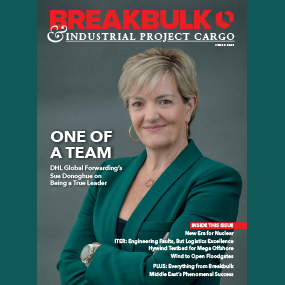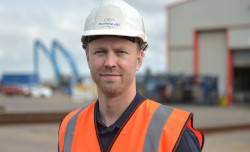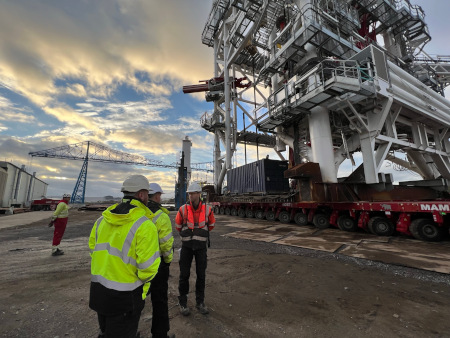Project Calls for Careful Calculations to Ensure Bridge Clearance
_1.jpg)
By Malcolm Ramsay

Shipping high precision components across the world’s ocean is undoubtedly complex, but all too often the largest challenges in any project arise in the first few miles of transport, navigating infrastructure limitations and environmental obstacles.
Project cargo specialist Bertling Logistics recently met one such challenge, delivering a high-tech intervention tower through tight draft restrictions and tidal limits on the river Tees in the UK before onward shipment to Singapore.
This complex project required a tailor-made engineering solution and saw Bertling work closely with client FTAI Ocean and local partners to ensure seamless delivery of the advanced Smart Tower System, destined for FTAI Ocean’s flagship DP3 Well Intervention vessel, Pride.
“We were initially approached for the feasibility study in 2019 and invited to tender in 2020,” Stephanie Lüning, director of tendering and marketing at Bertling Logistics, told Breakbulk, noting that an initial feasibility study quickly showed “that different lifting methods were required.”
This is when Bertling Logistics’ in-house technical and engineering team in Middlesbrough came into play. Former technical director Mike Hetherington (now retired) and Chris Wightman, engineering director, started to study the logistical requirements for this challenging project.
The tower system was to be collected from Port Clarence on the river Tees but then had to be transported to a stowage point downstream at Tees docks. Although this was only a few kilometers, the cargo had to navigate the historic Tees Transporter Bridge and contend with the tidal nature of the river along this stretch.
 “To find the best technical and commercial solution, Bertling Logistics performed a study for all possible shipment modes, including heavy-lift vessels, gearless vessels with shore/ floating cranes, and roll-on, roll-off vessels,” Wightman noted, adding that ultimately “there was only one stowage option which was jointly elaborated by us and Rolldock.”
“To find the best technical and commercial solution, Bertling Logistics performed a study for all possible shipment modes, including heavy-lift vessels, gearless vessels with shore/ floating cranes, and roll-on, roll-off vessels,” Wightman noted, adding that ultimately “there was only one stowage option which was jointly elaborated by us and Rolldock.”
RESTRICTED BY LIMITED DRAUGHT
Conveniently, the starting location at Port Clarence was close to Bertling Logistics’ home, as its heavy-lift and engineering office is based in Middlesbrough. As a result, the team was very familiar with the area and quickly able to identify the potential challenges.
The tower system was developed by offshore technology supplier Osbit and fabricated by nearby manufacturing specialist Wilton Engineering Services in Port Clarence. Comprising 1,300 tonnes of equipment in total, the tower itself weighed 909 tonnes and was designed with a vertical racking system to reduce its footprint, improving well center access once finally installed and maximizing deck space.
Calling the system a “world-class piece of kit,” Osbit director Steve Binney highlighted the “fantastic supply chain” in the region which allowed the complex cargo to be delivered effectively.
Despite the closeness of the fabrication site to the dock however, the size and weight of the tower raised several issues for the team. Measuring 40 meters in length and approaching one kilotonne in weight meant that the limited draft alongside the yard and headroom restriction downstream at the Tees Transporter Bridge would potentially be problematic.
“Addressing these two issues: to pass under the bridge, the tower had to be stowed inside the hull of the heavy-lift vessel; and to mitigate the draft issue, the tower would need to be ‘lightered’ by barge across the river to alongside the heavy-lift vessel where much deeper draft was available at the Port of Middlesbrough,” Wightman said.
Covering more than 40 hectares on the opposite bank of the river Tees, Port of Middlesborough has steadily developed into a hub for multimodal logistics solutions in recent years, with owner and operator of the port AV Dawson expanding its strategic investment in the site in late 2022.
Having carefully studied the project, Bertling proposed a solution to jack the tower up to self-propelled modular trailer height using perpetual climbing jacks, load to barge, then transfer to the waiting heavy-lift vessel, creating a solution that avoided the need for any lifting, relying on roll-on operations only.
“Lifting was only used for smaller equipment, which was a minor part of the operation,” Lüning said, adding that this was aided by the fact that the selected vessel had an open dock hull arrangement, albeit it was width-restricted in the hold by the aft vessel crane.
The vessel chosen was the RollDock Sky, a heavy load carrier with a draft of 5.8 meters and 6,884 deadweight-tonnes. To ensure seamless operations, Bertling worked closely with RollDock and the port harbormaster to study tidal curves and calculate the prime time for loading.
Rik Hofsté, head of bridge at RollDock, commented on the close partnership with Bertling, noting that all the team “enjoyed our cooperation” and benefited from the “support of Bertling during the transport of the unit on our vessel.”
From the calculations prepared by the partners, the team were able to see that passage under the Transporter Bridge would be possible during neap tides but that there were only six days per calendar month where this would be feasible.
EXECUTION TIME
 Utilizing four 500-tonne perpetual climbing jacks, the team then began the process of loading, relying on custom-designed jacking lugs retrofitted to the tower so that the SPMT could be inserted below.
Utilizing four 500-tonne perpetual climbing jacks, the team then began the process of loading, relying on custom-designed jacking lugs retrofitted to the tower so that the SPMT could be inserted below.
Following stowage of general cargo, the tower was then loaded aboard a barge at Port Clarence using Mammoet SPMTs and conveyed across the river to the RollDock Sky in preparation for the journey downstream where further components were scheduled to be loaded.
The teams then completed final sea fastening and loading of containerized cargo, keeping a close watch on the weather and tidal conditions to find the ideal window to progress.
With everything in place, the vessel set off in late October 2022, clearing the Tees Transporter Bridge with just over one meter clearance. After docking downstream to load the remaining cargo, the vessel then set off on its 6,700-mile journey to Singapore.
Due to the 40-meter height of the tower, however, close monitoring was still required as acceleration forces during the voyage posed the potential to damage the high-tech cargo.
“We relied on daily forecasts via the Met Office in the UK during UK operations,” Wightman said, adding that the Rolldock vessel utilized software for weather forecasting at sea and potential shelter scenarios.
From Middlesborough, the RollDock Sky sailed via the Suez Canal, Indian Ocean, and strait of Malacca, arriving in Singapore at the tail end of 2022.
“The intervention tower landed in PaxOcean Yard in Singapore after a long journey from Port Clarence with the RollDock Sky,” a spokesperson for RollDock commented.
SAFE ARRIVAL CELEBRATED
Having safely docked at PaxOcean Yard, the large cargo then had to be offloaded and again draft limitations required the team to work closely with local partners to ensure safe movement.
“During the roll-off in Singapore, some engineering challenges arose and were solved to ensure smooth rolloff,” Wightman noted, highlighting the additional survey work and ramp construction required to deal with limited draft at the receiving jetty and the resultant deployment of spacer barges to solve this problem.
With the cargo landed, the tower was then reloaded onto SPMT trailers and rolled out of the vessel one month and two days after it had started its journey.
Archie Sena, senior hull engineer at PaxOcean, praised the teamwork that ensured the cargo was moved through the yard in a timely fashion, commenting that the team was “happy and proud” to be “involved in this roll-out activity.”
Established in 2007, PaxOcean owns and operates five shipyards located in Singapore, China and Indonesia. Its shipyard in Tuas, Singapore was established in 1983 and covers a 110,000 square meter site with three floating docks and berthing space of 1,600 meters.
Having successfully delivered the cargo to the client, installation of the tower was then able to commence aboard FTAI’s Pride. Hailing the delivery as a “milestone achievement,” FTAI now expects the tower to play a key role in its deep-sea intervention services as it extends its capabilities to water depths of 1,500 meters.
Headquartered in Singapore, FTAI Ocean provides vessel-based well intervention, well-enhancement, plug & abandonment and related subsea services for the oil and gas industry and its flagship vessel is at the heart of this work offering subsea riser-less package and topside handling systems to provide clients with a range of services for their intervention solutions.
An advanced DP3 vessel with 2,000 cubic meters of deck space, the Pride was built in Canada in 2014 and features a 250-ton active heave compensating crane, a 35-ton auxiliary crane, a 7.2m-by-7.2m moonpool, and 6,000 tons of cargo carrying capacity.
Based in the UK, Malcolm Ramsay has a background in business analysis and technology writing, with an emphasis on transportation and ports.
PHOTO CREDITS: BERTLING LOGISTICS
